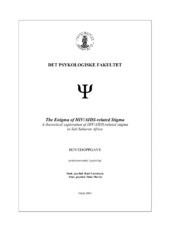The Enigma of HIV/AIDS-related Stigma. A theoretical exploration of HIV/AIDS-related stigma in Sub Saharan Africa
Master thesis
Permanent lenke
https://hdl.handle.net/1956/1813Utgivelsesdato
2003Metadata
Vis full innførselSamlinger
Sammendrag
29.4 million people are living with HIV/AIDS in Sub Saharan Africa. Despite this high prevalence, HIV/AIDS is a highly stigmatised disease. The United Nations Programme on HIV/AIDS recognize HIV/AIDS-related stigma as one of the greatest barriers to preventing further infections, and to providing adequate treatment, care and support for people living with HIV/AIDS. Stigma, under the slogan Live and let live , is also the focus of the World AIDS Campaign for 2002-2003. This thesis provides a conceptual framework for understanding HIV/AIDS-related stigma in Sub Saharan Africa. Based on this framework and its implications, strategies aimed at alleviating and preventing stigma are proposed. HIV/AIDS-related stigma is understood as a dynamic, multifaceted phenomenon that emerges from the intertwinement of human motivations, social structures, discourses and power relations. This understanding of stigma implies taking a broad approach when responding to stigma, calling attention to the importance of involving all levels of the community. Community psychology and community counselling provide suitable frameworks for such an approach, as they emphasize local adaptation, empowerment and action research. Because the severity of the HIV/AIDS-epidemic requires urgent response, research and action need to be integrated. Ethical and methodological issues pertaining to the understanding, alleviation and prevention of HIV/AIDS-related stigma in Sub Saharan Africa are taken into consideration. 29.4 millioner mennesker er smittet av HIV/AIDS i Afrika sør for Sahara. Til tross for den store utbredelsen av HIV/AIDS i mange afrikanske land, er sykdommen i stor grad stigmatisert. Stigma anses som ett av de største hindre for effektiv forebygging av HIV/AIDS, og HIV/AIDS-relatert stigma begrenser pleie og omsorg for smittede og berørte. Dette har ført til at HIV/AIDS-relatert stigma har blitt satt på dagsordenen av FNs HIV/AIDS program (UNAIDS). HIV/AIDS-relatert stigma har også blitt lansert som tema for Verdens AIDS kampanje 2002-2003, under slagordet Live and let live . Denne oppgaven gir ett konseptuelt rammeverk for å forstå HIV/AIDS-relatert stigma i Afrika sør for Sahara. Basert på denne forståelsen impliseres mulige tiltak for lindring og forebygging av HIV/AIDS- relatert stigma. HIV/AIDS-relatert stigma forstås som et dynamisk og komplekst fenomen som springer ut av interaksjonen mellom menneskelige motivasjoner, sosiale strukturer, diskurser og differensierte maktforhold. En slik forståelse krever en bred tilnærming med tanke på forebygging og lindring av HIV/AIDS- relatert stigma. Samfunnspsykologi og samfunnsrådgivning bidrar med egnede metodiske tilnærminger, da lokal tilpasning, lokal styring og aksjonsforskning er viktige mål. Fordi HIV/AIDS- epidemiens omfang krever en umiddelbar innsats, bør forskning og handling integreres. Metodiske og etiske utfordringer knyttet til forståelsen, lindringen og forebyggingen av HIV/AIDS-relatert stigma i Afrika sør for Sahara diskuteres underveis.
Utgiver
The University of BergenOpphavsrett
Copyright the author. All rights reservedThe author
